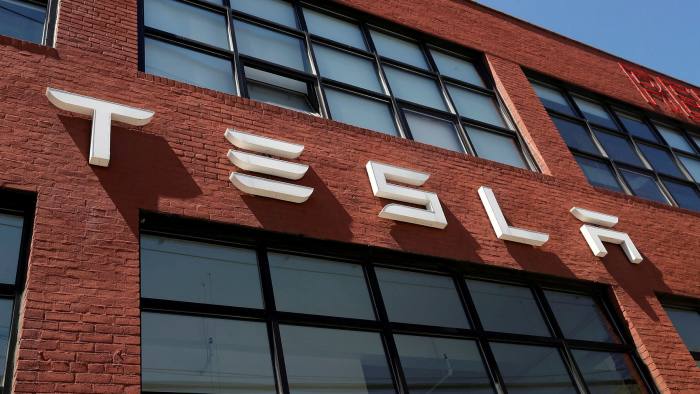Tesla’s stellar earnings fail to enchant investors
When you pitch an ever brighter future, you better hope it doesn’t darken.
3 hours ago

© REUTERS
Whenever Tesla’s earnings deck for the quarter lands, FT Alphaville has a little trick: we pull up the PDF and hit ctrl + F and type in a few choice words to see what accounting chicanery the company has been up to over the three months to make its numbers. For, while it’s arguably true that Wall Street is too focused on short-term financials (as Tesla’s shareholders often allege), it’s also true that there are few companies so myopic about hitting estimates as Elon Musk’s $634bn electric car company.
This quarter, however, FT Alphaville’s inspection drew a blank. In fact, the financials were remarkably clean. There were no bitcoin sales to boost the bottom line, the amount of pure profit zero emission credits sold declined both year-on-year and quarter-on-quarter and, to boot, Tesla boasted record automative gross margins over a period with of rising raw material costs and widespread supply chain disruption.
Combined with revenues almost doubling year-on-year to $12bn, and a slight decline in both research and development and interest rates costs meant Tesla recorded its highest GAAP net income -- $1.14bn -- in history. Perhaps even more impressive, in a quarter in which analysts expected a free cash flow burn of $319m, the company managed to churn out $619m of the green stuff.
You’d think with record revenues, record gross margins, and record profits investors would be giddy. And you’d be sort of right. In pre-market, Tesla’s shares are up. But a move of just 1.6 per cent feels particularly mute for a scrip that is widely renown for its manic volatility.
So what’s going on?
If you ask FT Alphaville, the problem seems to be expectations. Having bid Tesla’s market capitalisation up to the collective value of eight General Motors, investors now expect its current crop of products -- whether it be the Model 3, the Model S Plaid, or its still diminutive solar business -- to deliver. What matters more than ever, is the company’s future. And that’s where it gets a little hazier.
Tesla’s current product roadmap amounts to its Full Self Driving autonomous software (announced: October 2016), the Semi-truck (announced: November 2017), the Roadster 2 (announced: November 2017), the Cybertruck (announced: November 2019) and a mooted low cost Model 2 (announcement: tbc). And on the conference call, when asked about this product line-up, management’s answers got a little squiffy.
For instance, you might know that since early July, Tesla has been offering a beta version of its Full Self Driving software to its US customers for $199 per month (plus $1,000 if you don’t have the correct hardware). Do note that Tesla states on its website the product is not fully autonomous.
So how’s that launch going? Well, here’s Elon’s answer to analyst Pierre Ferragu on the call when he was asked about the software package’s uptake so far (our emphasis, transcript from Sentieo):
...We need to make full self-driving work in order for it to be a compelling value proposition. Otherwise, people are kind of betting on the future.
I mean, like right now, is it -- does it make sense for somebody to do FSD subscription? I think it’s debatable. But once we have full self-driving widely deployed, then the value proposition will be clear. And at that point, I think basically everyone will use it or be rare -- a rare individual who doesn’t.
Not exactly a ringing endorsement of the tech. Particularly when you consider Google’s Waymo has been running a fully autonomous taxi service in Phoenix for over a year, Cruise has been testing driverless carsin San Francisco since December, and former Tesla partner Mobileye has been doing similar in New York. In fact in California, Tesla’s home state, it doesn’t even have a licence to operate driverless cars. As for the software itself, even Tesla’s superfans are struggling to muster excitement about its current capabilities. For a product on which bulls like ARK Invest seems to have put so much stock, it seems a long way off its rivals.
Away from products ranging from those that sort-of exist to those that don’t, we also had news of the Semi-truck and Cybertruck. Both weremeant to enter production at the end of this year at Tesla’s new plant in Austin, and both have been delayed to be next. The Semi because of chinks in the manufacturing process of its new 4680 battery cell (announced: September 2020), and the Cybertruck because of semiconductor supply and, in Elon’s words:
Nobody’s ever really made a car like this before, a vehicle like this before. So there’ll probably be challenges because there’s so much unexplored territory.
Remind anyone of the Model X’s infamously tricky to manufacture gulf wing doors?
As for the almost half a decade old Roadster 2 and the theorised cheaper car? We guess no news is not exactly good news.
Still, there’s no doubt the numbers were good. But at a valuation of 12 times forward revenues, the market reaction suggests that’s the minimum investors were expecting. And with Elon announcing he probably won’t be on earnings calls in the future unless “there’s something really important I need to say” and its product pipeline receding ever further into the future, shareholders might be hoping for a grand return sooner rather than later.

